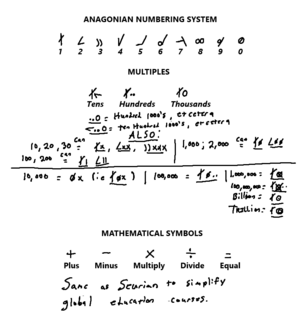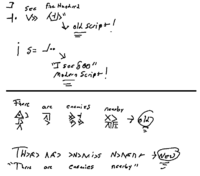Evolution of Anagonian Number & Mathematics
The development of numbers and mathematics in Anagonian language, from Pre-Seurian era into the Modern, reflects the nation’s journey from primitive counting systems to complex numerical representations, influenced by both draconic traditions and external cultures. Early Anagonians relied on basic tally marks, derived from the claw-like symbols of the Draconic Script, to denote quantities. These symbols were primarily used for rituals, trade, and territorial markings, and could represent simple counts or multiples, such as tens or hundreds, using dots and slashes to indicate larger numbers.
Pre-Seurian Mathematics: The Draconic Bane
While the early Anagonians revered the dragons for their wisdom and strength, mathematics was not exactly the strong suit of these ancient, towering creatures. Draconic mathematics, if it could be called that, was limited to basic counting and symbolic representations of quantities, largely for practical purposes such as marking territory or tracking ritual offerings. The dragons, though intelligent and wise in many ways, viewed mathematics as unnecessary drudgery, a bane that served little purpose in their lives of power and dominance. For them, the natural world was measured through instinct and intuition, rather than precise calculation.
The early Anagonians adopted this primitive mathematical system, relying on claw-like symbols scratched into stone or clay to represent simple numbers. A single slash might denote one unit, while additional marks indicated multiples. The use of dots and slashes to represent tens or hundreds allowed for some larger counts, but there was no concept of complex calculations or abstract mathematical principles. Numbers were largely tied to ritualistic purposes, with certain quantities being seen as sacred or imbued with spiritual meaning.
However, the limitations of this system soon became apparent as Anagonia’s society advanced. While dragons had little need for advanced calculations, humans increasingly required more precise and versatile methods for counting resources, organizing trade, and expanding governance. The dragons’ system, despite its simplicity and effectiveness for their needs, was soon seen as a hindrance to human progress.
Post-Seurian Mathematics: Numerical Renaissance
The arrival of the Seurians brought about a transformative period in Anagonia’s history, particularly in the realm of mathematics. Often referred to as a Numerical Renaissance, this era saw the introduction of the Seurian base-10 system, which revolutionized the way Anagonians approached numbers and calculations. Unlike the primitive draconic system, which relied on simple tallies and ritualistic meanings, the Seurian approach to mathematics introduced structured symbols for numerals, as well as operations like addition, subtraction, multiplication, and division. This allowed Anagonians to move from basic counting to complex arithmetic, a development that would fuel the nation’s economic and technological progress.
Seurian mathematics introduced the concept of positional value—the idea that the position of a digit affects its value—which enabled Anagonians to work with larger numbers and perform more sophisticated calculations. This advancement was crucial for the organization of the expanding Mal-Videnus Commonwealth, as it provided the mathematical foundation necessary for everything from taxation and resource management to architecture and engineering.
With this new system, Anagonia entered an era of intellectual growth, as scholars and traders quickly adopted and adapted Seurian principles to fit the needs of their growing society. The Numerical Renaissance laid the groundwork for Anagonia’s technological innovations, establishing a tradition of mathematical excellence that would continue into the modern age.
The Modern Era: Freedom of Mathematics
In the modern era, Anagonia has fully embraced the freedom of mathematics, pushing the boundaries of numerical theory, applied sciences, and technology. Building on the foundations laid during the Numerical Renaissance, the Anagonian people have moved beyond the rigid systems of the past and entered a period of intellectual liberation. Mathematics is no longer just a tool for governance and trade—it has become an essential part of everyday life, driving scientific discovery, technological innovation, and even the arts.
With the rise of computers, artificial intelligence, and automation, mathematics has found new applications in areas ranging from space exploration to environmental preservation. The digital revolution has allowed Anagonians to create advanced algorithms and models that can solve complex problems in real-time. This newfound flexibility has led to the development of new mathematical fields, such as quantum computing and cryptography, which have become vital for national security and global communications.
Mathematics education has also seen a renaissance of its own. Students from all walks of life are encouraged to engage with numbers, from basic arithmetic to high-level calculus and theoretical physics. The introduction of digital learning platforms has made math accessible to everyone, enabling people to explore the freedom of mathematical expression in new and exciting ways. The blending of traditional Anagonian values with modern mathematical innovation reflects the nation’s ongoing quest for progress, excellence, and the freedom to explore new frontiers.
Key Milestones in Mathematical Evolution
Key milestones in the evolution of Anagonian mathematics include:
- Pre-Seurian Era: In ancient times, numerical concepts were rudimentary, focused mainly on practical uses like tracking resources or marking distances. The early system was heavily tied to ritual practices, where numbers often represented spiritual concepts connected to dragons and natural phenomena. However, these systems were limited in their ability to handle large quantities or complex calculations.
- Seurian Influence: The introduction of the Seurian numeric system during the Seurian invasion revolutionized Anagonia’s approach to numbers. The Seurians brought a more structured system capable of handling advanced arithmetic, which was quickly adopted by Anagonian scholars and traders. The base-10 system, along with symbols for addition, subtraction, multiplication, and division, enabled Anagonia to develop more sophisticated forms of mathematics.
- Mal-Videnus Commonwealth and Standardization: During the formation of the Mal-Videnus Commonwealth, the Seurian numeric system was integrated with elements of the traditional draconic counting system to create a unified system for use in governance and trade. This new system expanded to include formal notation for mathematical operations, allowing Anagonia to engage in complex engineering and architectural projects.
- Modern Era and Digitalization: In the modern era, Anagonia’s numeric system has been adapted for use in technology, including computers, financial systems, and scientific applications. The shift to digital formats required the script to be optimized for precision and efficiency, resulting in the creation of modern mathematical symbols and fonts that blend traditional aesthetics with contemporary functionality.
Mathematical Symbolism in Religious or Cultural Contexts
In Anagonian history, mathematics has played a significant role in religious and cultural practices, especially in connection to the Draconic faith and the ancient worship of dragons. Numbers, seen as sacred and symbolic, were often tied to ritualistic meanings and have been integrated into the design of cultural artifacts, temples, and sacred geometry.
Ritualistic Numbers and Draconic Faith
In the Drekanity religion, numbers such as three, seven, and twelve hold deep spiritual meaning. These numbers are believed to reflect the divine connection between dragons and the natural world, each representing important aspects of life and creation:
- Three symbolizes the triad of power: strength, wisdom, and flight—core virtues attributed to the dragons.
- Seven represents the seven sacred mountains where dragons are said to rest, a number associated with divine protection and spiritual journeys.
- Twelve is often tied to the twelve cycles of the moons, representing time and eternal continuity.
During religious ceremonies, these numbers are often repeated in the form of chants or sacred draconic inscriptions, reinforcing their importance. Temples dedicated to Melkos Unchanos, the Patron God of Drekanity, are built according to sacred geometry, incorporating these numbers into their architectural designs. For instance, seven pillars might surround a central altar, or the layout of the structure could be based on triangular shapes, symbolizing strength and unity.
Cultural Artifacts and Mathematical Design
In ancient Anagonian society, the use of mathematical symbolism extended beyond religion and found its way into art, jewelry, and weapons. Artifacts recovered from early tribal Anagonians often depict intricate geometric patterns that adhere to sacred numerical systems. These patterns are believed to serve as protection symbols or talismans blessed by the gods.
For example:
- Ceremonial swords and daggers often feature seven notches along their blades, symbolizing divine favor and ensuring victory in battle.
- Draconic jewelry, worn by priests or warriors, frequently uses numbers like three and twelve in their designs, with rings or necklaces crafted to reflect the cyclical nature of time and the balance of the physical and spiritual worlds.
Mathematical Symbols in Sacred Writings
The use of mathematical symbols in sacred writings was common in ancient times, with ritualistic texts featuring geometric shapes that represented numerical concepts related to spiritual themes. Numbers like seven were often written using specific draconic glyphs in prayer books or on the walls of sacred caves, marking key points of ritual sequences or divine events.
In modern times, this connection to mathematics remains intact through religious festivals and cultural ceremonies where numbers are still regarded as powerful tools of protection, guidance, and balance.

